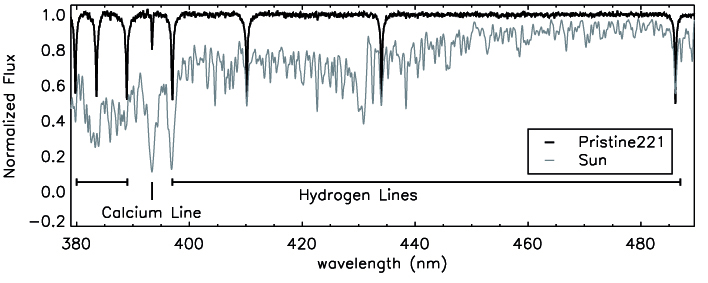ING web news release
8 October, 2018
Approaching the Galactic Metallicity Floor with the Discovery of an Ultra-Metal-Poor Star
The Pristine Survey allows astronomers to look for and research the oldest stars in our
universe, with the goal of learning more about the young universe right after the Big Bang. Recently, the survey team
reported on the discovery of a particularly metal-poor star, Pristine 221.8781+9.7844, in the Monthly Notices of the Royal Astronomical Society journal.
For the study of the early universe astronomers have different methods at their disposal: one is to look
far into the Universe and back in time, to see the first stars and galaxies growing. Another option is to
examine the oldest surviving stars of our home galaxy, the Milky Way. The "Pristine" survey, led by Else Starkenburg (Leibniz Institute for Astrophysics Potsdam, AIP) and Nicolas Martin (CNRS/INSU, University of
Strasbourg), is looking for exactly these pristine stars.
The scientists employ a special colour filter on the Canada-France-Hawaii Telescope to search for stars
with relatively pristine atmospheres. Detailed follow-up studies
with ISIS on the William Herschel Telescope (WHT) and IDS on the Isaac Newton Telescope (INT), and telescopes of the European Southern Observatory in
Chile, have demonstrated that the star has indeed very few heavy elements in its atmosphere.
|

|
The medium-resolution spectrum for Pristine 221.8781+9.7844 as observed with WHT/ISIS. One can
clearly see that the medium-resolution spectrum is dominated by the H Balmer series. The weaker Ca II line is the Ca II K line, the Ca II H line is blended
with Hε and it looks much stronger.
Credit: Else Starkenburg. Large format: [ JPEG ].
|
"In this star, most chemical elements are depleted by factors 10,000 to 100,000 compared to the Sun. Additionally, the composition is distinctive. Whereas most heavy-element-depleted stars show a large
enhancement in carbon, this star does not. This makes this star the second of its kind and an important
messenger from the early Universe", says Dr. Else Starkenburg.
To find these oldest messengers among the much larger population of younger stars is no easy task.
Just after the Big Bang, the Universe was filled with hydrogen and helium and a bit of lithium. No
heavier elements were around, as these are only synthesised in the hot interior of stars - and those did
not yet existt.
Our Sun has about 2% of heavier elements in its atmosphere, as can be seen from a spectrum of its light.
Because of this, astrophysicists can conclude that the Sun has
emerged as part of a later generation of stars - and "recycled" in its atmosphere are the products of some
stars that lived long before the Sun and no longer exists.
In searching for the oldest stars, astronomers look for stars with more pristine atmospheres than our Sun.
The more pristine the atmosphere, the earlier the star was born. Studying
stars of different ages allows us to understand the history of the Galaxy - an area of research
that therefore is also called Galactic archaeology.
More information:
Starkenburg, Else; Aguado, David S.; Bonifacio, Piercarlo; Caffau, Elisabetta; Jablonka, Pascale; Lardo, Carmela; Martin, Nicolas; Sánchez-Janssen, Rubén; Sestito, Federico; Venn, Kim A.; Youakim, Kris; Prieto, Carlos Allende; Arentsen, Anke; Gentile, Marc; Hernández, Jonay I. González; Kielty, Collin; Koppelman, Helmer H.; Longeard, Nicolas; Tolstoy, Eline; Carlberg, Raymond G.; Côté, Patrick; Fouesneau, Morgan; Hill, Vanessa; McConnachie, Alan W.; Navarro, Julio F., 2018, "The Pristine Survey IV: Approaching the Galactic metallicity floor with the discovery of an ultra metal-poor star", MNRAS, sty2276 [ ADS | MNRAS ]
"Journey to the Beginning of Time", AIP press release, 8th October 2018.
"Arqueología galáctica", IAC press release, 8th October 2018.
|
|



